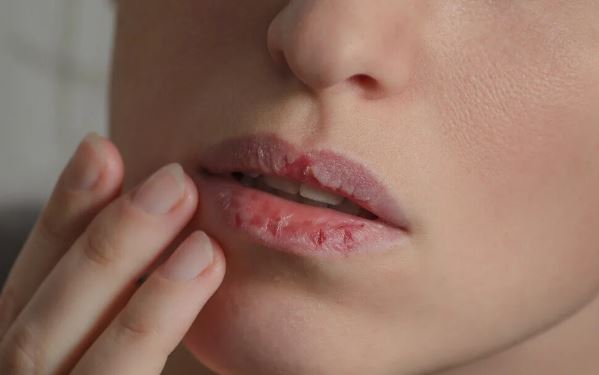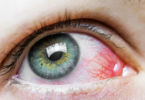The appearance of the different parts of the body gives an idea of the general state of the organism. In this sense, color changes in the lips are usually due to the presence of underlying pathologies.

The skin and mucous membranes are the main defense barrier of the human body. In general, they express the state of internal health. On some occasions, they may indicate the presence of a condition, deficiency or pathology. Are you interested in knowing what color changes mean on the lips?
The lips are one of the most sensitive and delicate facial tissues that exist; they have more than a million nerve receptors. These owe their color to the presence of abundant blood vessels that run under their surface. Similarly, race and skin color also play a role.
The healthy look typically ranges from a light pink to a shade of brown. However, there are color changes on the lips that can indicate that something is not going well. These variations range from partial spots to blue or purplish, whitish and blackish colorations.
Why do lip color changes occur?
The skin of the lips is usually susceptible to external factors that alter its composition and physiology; an example of this is the cigarette. On the other hand, many diseases are manifested by injuries or alterations there. Some studies claim that the appearance of facial soft tissues reflects the condition of the underlying hard tissues.
Lip color changes are often attributed to a long list of conditions. Dehydration, nutritional deficiencies, and exposure to sunlight are common causes. However, they are also usually a means of clinical expression of cardiovascular, respiratory, oncological and hematological pathologies.
Whitish lips
The manifestation of white or pale lips is usually associated with dehydration and a decrease in the number of red blood cells or anemia. In general, this sign is accompanied by an evident paleness in the rest of the body, in the conjunctiva, in the gums and under the nails of the hands and feet.
The most common cause of dehydration is estimated to be diarrhea, especially in children and adolescents. In addition, fluid loss can be associated with internal or external bleeding, such as heavy menstrual bleeding.
In most patients, anemia is usually the result of nutritional deficiencies. Such is the case of the low intake or absorption of iron, vitamin B 12 and folic acid. Also, some inherited diseases like thalassemia or hemophilia can cause it.

Anemia is expressed with paleness, tiredness and exhaustion. In children it can affect school performance.
Blue lips
Bluish discoloration of the lips, skin, and other mucosa is clinically recognized as cyanosis. The red color of the blood is a result of the concentration of hemoglobin in it. However, according to studies, the blood turns dark or purplish in color when oxygen is low, which determines the manifestation of cyanosis.
The evidence of lips, fingers and blue mucous membranes is usually the product of respiratory and cardiovascular pathologies. Chronic obstructive pulmonary disease (COPD), asthma, mechanical asphyxia, and respiratory failure are the most common etiologies.
On the other hand, heart failure, shock, sepsis, low temperatures, and insecticide poisoning can cause this condition. In addition, some congenital disorders, such as ventricular septal defect and vascular malformations, are associated with blue lips.
Black lips
The blackish coloration of the lips is usually related to lesions of the oral mucosa or pathological processes that promote the production of melanin. Hyperpigmentation of the lips and skin is a common finding in Addison’s disease. This is a disease characterized by deficiency in the production of cortisol and aldosterone.
On the other hand, studies estimate that the continuous consumption of tobacco and cigarettes influences the dark pigmentation of the labial, gingival and periodontal mucosa. In addition, bruising from trauma and burns can give the lips a black or purplish tint.
Stains on the lips
The presence of spots of variable diameter and shape on the lips is associated with a long list of agents. Pigmentations from the sun’s ultraviolet rays are the most common cause.
They usually manifest themselves with shades that vary from beige to dark brown. You can also find color changes in the lips due to spots in the following cases:
Hemochromatosis.
Laugier-Hunziker disease.
Peutz-Jeghers disease.
Oral neoplasms.
Antipsychotic drugs, such as chlorpromazine.
Diagnosis and treatment for different color changes on the lips
Diagnosis of lip color changes is based on a comprehensive physical examination by the doctor. Similarly, the physician must consider the presence of other associated clinical manifestations, such as variations in skin tone in other parts of the body.
The presence of cardiovascular or respiratory symptoms and signs favors diagnostic orientation. In addition, the doctor must consider the patient’s habits, as well as family history and previous pathologies. In some cases, biopsies may be helpful in suspected neoplasms.
Treatment is usually aimed at treating the underlying disease that is causing the manifestation on the lips. For this, the specialist can use means of hydration, nutrient replacement and oxygen administration.
The use of laser, intense pulsed light, cryotherapy and phototherapy are intended for the treatment of hyperpigmentary pathologies that are causing color changes on the lips. In addition, some topical medications are often referred to as part of the therapy.

The lips present changes that orient towards oral or systemic pathologies. Treatments will be derived from their recognition.
Lifestyle and prevention
The skin of the lips is very delicate, so continuous care of it is essential. To do this, it is advisable to use hydration balms and sun protection, as well as reduce direct exposure to the sun’s rays.
For its part, a balanced diet that includes all vitamins and minerals helps reduce the risk of anemia and changes in lip color. Adequate water intake is advisable to ensure adequate hydration.
Smoking cessation offers excellent results for people’s oral, respiratory and cardiovascular health. Therefore, it can be started by setting goals and establishing the smoking cessation plan in direct consultation with a specialist.
When to go to the doctor if I notice changes in the color of my lips?
Early identification of lip color changes favors the prognosis for most patients. In this sense, you should see a doctor in case you notice an increase or decrease in tonality, especially if it is accompanied by other symptoms.
Given the evidence of bluish or cyanotic coloration associated with respiratory distress, emergency medical assistance should be sought. In this way, timely treatment of any serious pathology can be carried out, preventing possible complications and sequelae.





